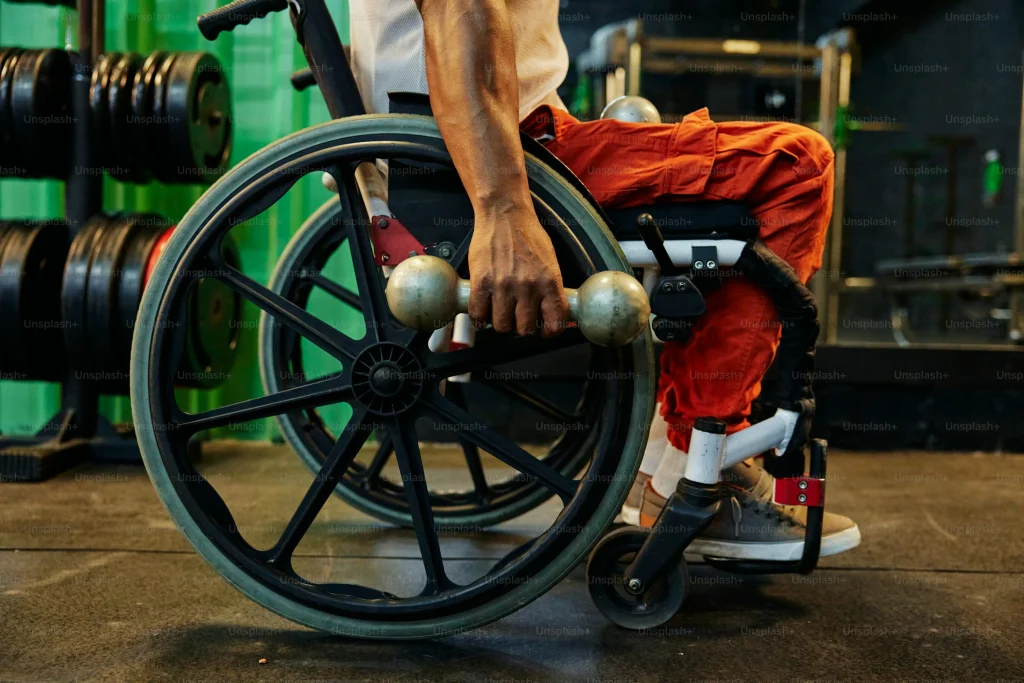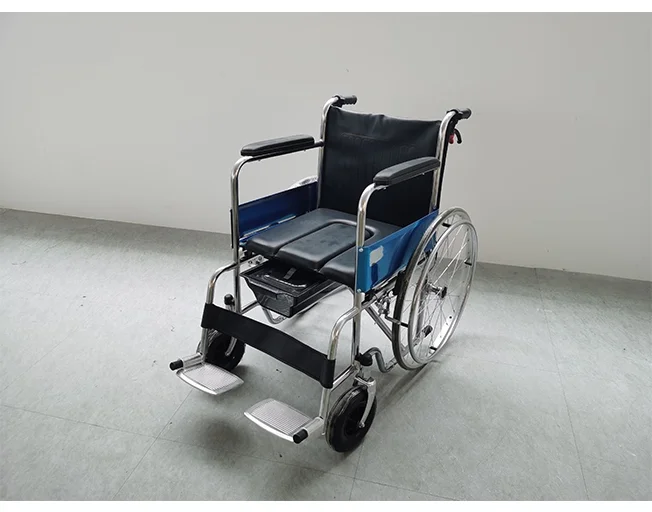What Role Do Wheelchair Front Wheels Play in Optimal Wheel Placement?
Time : Aug 23, 2025 View : 1,408
Front wheels, or casters, are key to how a wheelchair moves and feels. They guide the chair, affect balance, and shape the user’s experience across different surfaces. Let’s break down their mechanics and how they work with other parts to make a wheelchair fit your needs just right.

The Mechanics of Wheelchair Front Wheels
The front wheels set the stage for how a wheelchair handles steering and stability. Their design and placement are critical for smooth navigation, whether you’re indoors or out. Here’s how they do it.
- Structural Function of Front Casters in Wheelchairs: Front wheels on a wheelchair, or casters as folks call ‘em, are the steering champs. They’re up front, swiveling to let you zip around corners or squeeze through tight spots indoors. A wheelchair’s got its front frame, rear frame, U-frame, backrest, armrests, foot pedals, brakes, front and rear wheels, plus a comfy seat back pad. These casters, small and nimble, keep you turning smoothly while holding the chair steady when you’re pushing along.
- Influence of Front Wheel Size and Material on Performance: The size and stuff the casters are made of make a big difference in how your chair handles. Take the XY-608J—it rocks an 8-inch PVC solid wheel, tough and low-maintenance. Smaller ones, like the 6-inch PU wheels on the XY-C06-20, are awesome for zipping around inside but can get shaky on bumpy outdoor paths. PVC versus PU? It’s about how much bounce or smoothness you get. PU wheels tend to glide better over rough ground.

- The Interaction Between Front Wheels and Rear Wheel Placement: Where you stick the front and rear wheels changes how the chair balances your weight. Push the rear axle forward, and more weight lands on those front casters—makes turning a breeze but can feel jarring on uneven ground. Slide that axle back, though, and the ride gets smoother, with less weight on the casters, though it might slow your turns a bit. Getting this balance right is key to setting up a chair that fits your life, whether you’re indoors or out.
Impact of Front Wheel Configuration on Maneuverability
Caster setup directly affects how nimbly you can move and how steady the chair feels. Let’s dive into the ways this impacts your daily navigation.
How Caster Position Affects Turning Radius and Stability: Where those casters sit messes with how tight you can turn. A shorter wheelbase and sharper caster angle mean a smaller turning circle—great for quick spins in tight spaces. The XY-1001A manual says a turning radius of 860mm or less is ideal for indoor zipping. But go too sharp with the angles, and the chair might wobble during fast turns or when you’re heading down a slope.
Effects on Indoor vs. Outdoor Navigation: Smaller casters, like 6-inch PVC or PU ones, are your best bet for cruising around inside—they glide over flat floors like nobody’s business. Outdoors, though? You’ll want bigger casters or ones that soak up bumps to tackle rough ground without rattling your bones. Stick to flat surfaces, as the manual warns—uneven roads can make things tippy or shaky.
Influence on Center of Gravity and Tipping Risk: The chair’s center of gravity hinges on where the wheels sit. Too far forward, and you’re risking a tip when braking hard or rolling downhill. The manual’s clear: don’t flip the chair or whip around on slopes, or it might nose-dive. Finding that sweet spot for wheel placement keeps you safe without making the chair feel like a clunky tank.
Optimizing Wheel Placement for Performance and User Needs
Getting the wheels set up right means balancing comfort, efficiency, and safety. Here’s how to tailor placement to your lifestyle and needs.
- Balancing Front and Rear Wheel Positions for Efficiency: Getting the weight split just right between front casters and rear wheels is the trick to a smooth, easy ride. Too much weight on either end, and you’re either fighting to push or wobbling like crazy. Adjustable axles let you tweak this setup to match your strength or how you move, keeping things comfy and efficient.
- Adjustments Based on Terrain, Speed, and User Activity Level: If you’re an active type, darting between indoor and outdoor spots, you need a different setup than someone chilling mostly at home. Bigger front casters paired with a slightly back-set axle soak up bumps at higher speeds and keep you in control on rough paths. It’s all about matching the chair to your vibe. For high-performance chairs tailored to these needs, check out models with adjustable axles and different caster sizes to fit your lifestyle.
- Clinical Considerations for Customizing Wheel Placement: Clinicians look at stuff like your posture, arm strength, or even muscle twitches when figuring out wheel placement. If your upper body’s not super strong, a forward axle cuts down on the effort to push, even if it makes the chair a tad less steady. It’s about saving your energy while keeping you safe, based on how you move and what you do daily.
XUNYU’s Innovations in Front Wheel Design
XUNYU Medical brings some smart engineering to wheelchair casters, blending comfort with top-notch control. Let’s check out their approach.
- Overview of XUNYU’s High-Performance Caster Systems: XUNYU Medical’s wheelchairs, like those in their Quality Wheelchairs for Safe Mobility lineup, come with slick caster systems built for both comfort and control. They offer solid PVC or PU casters from 6 to 8 inches, with fat-wheel options for extra grip on tricky surfaces—perfect for uneven floors or outdoor jaunts.
- Integration With Adjustable Rear Axle Systems in XUNYU Models: XUNYU’s got models with adjustable rear axles that work hand-in-hand with their fancy casters. You can tweak the center of gravity on the fly, which is awesome for adapting to new needs or switching up your routine without needing a whole new chair.
- Recommendations for Selecting the Right XUNYU Configuration: For tight spots like hospitals or homes with narrow doors, go for 6-inch solid PU wheels, like on the XY-C06-20—they’re nimble and quick. If you’re hitting sidewalks or ramps (stick to slopes under 5°, per the manual), an 8-inch fat-wheel caster gives better traction without losing too much turning speed. To make pushing easier and keep tipping risks low on slopes or sharp turns, pair bigger casters with a slightly rear-set axle. XUNYU’s adjustable setups, like those in the XY-608J or XY-809 series, let you dial in the perfect balance for your needs.
- Enhancing User Experience Through Precision Engineering: Users rave about how XUNYU’s smart caster designs and spot-on axle setups make switching between floor types a breeze. The XY-608J and XY-809 series get props for this, with Foshan Xunyu Medical Technology Co., Ltd. earning love for their custom OEM/ODM tweaks based on real user and clinician feedback.
- Long-Term Benefits of Proper Wheel Placement With XUNYU Solutions: Getting the wheels set up right cuts down on shoulder aches by making pushing easier and keeps injuries at bay by avoiding awkward postures. It also makes your chair last longer—XUNYU’s got a 5-year service life from delivery. That means more independence and confidence, all thanks to some clever engineering.
FAQ
Q: What size front wheel is best for indoor use?
A: A 6-inch solid PVC or PU wheel’s great for tight spaces—small turning radius makes it super maneuverable.
Q: How does tweaking the rear axle affect front wheel performance?
A: Sliding the rear axle forward puts more weight on the casters, boosting agility but maybe making rough surfaces feel bumpier.
Q: Can I customize my wheelchair’s wheel setup for my activity level?
A: Totally! XUNYU’s got adjustable axles and caster options to fit everyone, from couch potatoes to folks tackling all sorts of terrain daily.


